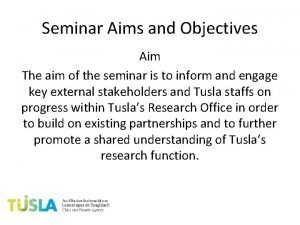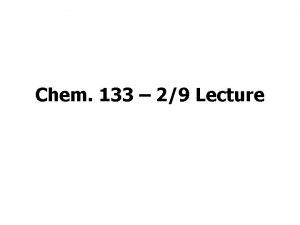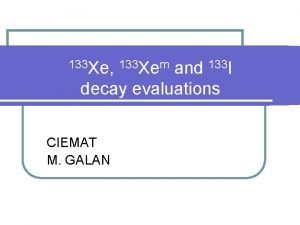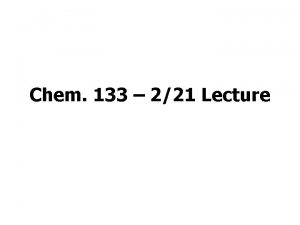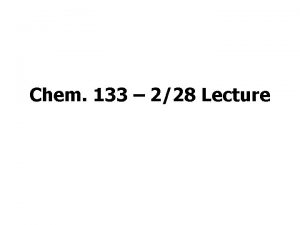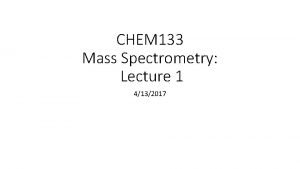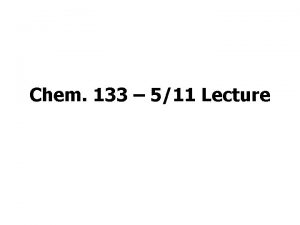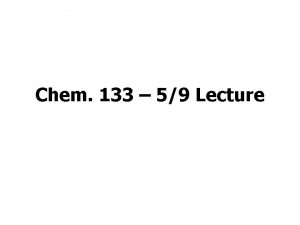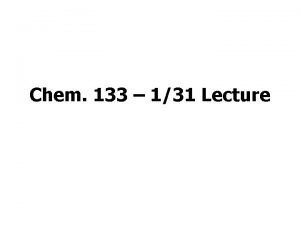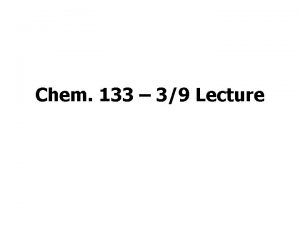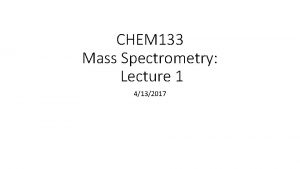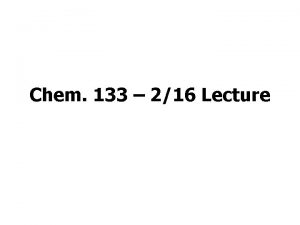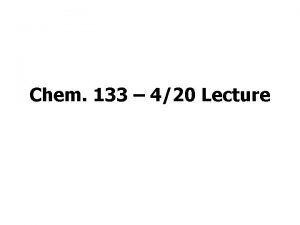Chem 133 29 Lecture Announcements Seminars on Friday


















- Slides: 18

Chem. 133 – 2/9 Lecture

Announcements • Seminars on Friday – Biochem. Position + Regular seminar • Today’s Lecture – Electrical Measurements • DVM measurement of I and R • Errors in measurements – Transducers – Operational Amplifiers (qualitatively – if we get to today)

Electrical Measurements Analog to Digital Conversion • How signal can be “lost”: – – • Exceed maximum voltage Below minimum voltage Insufficient resolution (bits) to pick up signal Insufficient speed to see fast processes Example question - A portion of a signal is collected from a GC detector and digitized (through an analog to digital converter). A peak comes out where marked. What is a clear problem with the digitization? peak Digitized Signal time a) sampling at too high of a frequency b) input voltage exceeding input range c) not enough bits in digitizer d) it is missing the Minecraft people

Electronics Digital Volt Meter (DVM) Measurement • Use of DVM for V, I, and R measurements voltage Shunt resistor Current Thermocouple + - Pair (generates V) Iout + - transducer DVM I = Vmeter/Rshunt DVM Multimeter

Electronics Digital Volt Meter (DVM) Measurement • Resistance Measurement thermistor Constant I source DVM multimeter example problem: The power source puts out 1. 00 m. A and the voltage read is 0. 722 V, calculate the resistance

Electronics DVM Measurements • Errors in Measurements – Errors in voltage measurements: • can occur if a device also has "internal resistance" • in combination with less than infinite resistance in DVM – Example: measurement of voltage from an ion selective electrode or p. H electrode. Calculate the error in voltage if a p. H electrode reads 0. 721 V and has an internal resistance of 830 kΩ if the DVM has a meter resistance of 10. 0 MΩ. – (go to blackboard) R(cell) R(meter) DVM Cell = p. H electrode

Electronics Transducers Definition: A transducer is a device that converts a physical (or chemical) property into an electrical signal Classifications: • • • By output measure (V, I, R, frequency) By phenomenon measured (charged particle flux, temperature, light intensity, surface modification) Internally vs. Externally Amplified

Transducers Charge Particle Detectors • Measurement of electrons, molecular ions and charged aerosol particles • Most common type for GC and MS detectors e- Charge Collector or Faraday Cup Can detect currents > 10 -15 A I

Transducers Charged Particle Detectors Electron Multiplier (MS detector) Detection Process 1. 2. M- e- e 3. I Cathode Dynodes 4. Charged particle hits cathode Electrons emitted from collision Amplificaion occurs with each stage Current (electron flux) increases before anode Example: if each stage produces 6 useful electrons out per ion in, amplification in current would be x 63 or x 216. With greater amplification, single particle detection is possible

Transducers Measurement of Temperature • Applications: – Temperature control (e. g. GC ovens) – Infrared light • Resistance based – Thermistors and platinum resistance thermometers (both have R = f(T)) • Voltage based – Thermocouples (voltage generated by metal junction which depends on T)

Transducers Detection of Light 1. Vacuum tube types - - - Based on photoelectron effect Current based detectors Photocells (see diagram) All have minimum energy (maximum wavelength) where electron ejection just occurs Photomultiplier tube (combination of photocell and electron multiplier) Photomultiplier tube allows detection of single photons e- hν I

Transducers Detection of Light 2. Solid state types - Typically less expensive than vacuum tube types - Tend to operate better at longer wavelengths - Based on promotion of electrons to conducting bands - Photodiodes (I proportional to intensity) - Photoconductivity cells (R dependent on intensity) - Photovoltaic cells (V dependent on intensity) - Advanced devices (discussed in spectroscopy section) - Arrays (1 D or 2 D sets of detectors) 1 D Photodiode Array + e- e n e- p Reversed-bias photodiode: High impedance until photons arrive

Some Questions on Transducers 1. 2. 3. 4. 5. List a transducer with a (primary) current signal. List a transducer with a (primary) resistance signal. List a transducer that can be used to measure charged particles. What is the main reason that a photomultiplier tube is more sensitive than a photocell? Give an example of a transducer that is readily available in an array form.

Operational Amplifiers • General Use: Analog Signal Processing • Common Uses – voltage amplification – current amplification (removal of effect of internal resistance) – current to voltage conversion – differential amplifier to remove common noise • This time – only covering qualitatively (no calculations problems)

Operational Amplifiers • Function – Requires power (+15 V/ -15 V) inverting – Has inverting and input noninverting inputs – Output voltage is equal to (gain)x(V+ – V-) (“real” op amp) – Main thing to know about real op amp is you can not connect the two input wires +15 V output + -15 V

Operational Amplifiers • “Ideal” Op Amp – V+ = V- (infinite gain) – I+ = I- = 0 (infinite input resistance) feedback circuit output + • Useful Circuits – All use feedback circuits – Example: voltage follower (current amplifier) – V(output) = -V(electrode) + electrode with Velectrode

Operational Amplifiers • Other Useful Circuits – Inverting amplifier • in text • Vout = -Rf. Vin/Rin • useful for amplifying voltage signals – Differential amplifier • in text • Vout = (Rf/Rin)(V 1 - V 2) • allows removal of noise common to V 1/V 2 – Current to voltage convertor • Typically uses large Rf for high sensitivity Rf transducer with current I +

 Fahrenheit 451 burning bright
Fahrenheit 451 burning bright Pvu announcements
Pvu announcements Kayl announcements
Kayl announcements /r/announcements
/r/announcements General announcements
General announcements Church announcements
Church announcements 01:640:244 lecture notes - lecture 15: plat, idah, farad
01:640:244 lecture notes - lecture 15: plat, idah, farad Cognitive coaching seminars
Cognitive coaching seminars Ubc student directed seminars
Ubc student directed seminars Objective of a seminar
Objective of a seminar Critical thinking seminars
Critical thinking seminars Eap seminars bendigo
Eap seminars bendigo Organising a seminar
Organising a seminar Alive seminars
Alive seminars Fix up seminars
Fix up seminars Ucsb frap
Ucsb frap Executive leadership seminars
Executive leadership seminars Omb circular a 133 audit
Omb circular a 133 audit 131 muhasebe kaydı
131 muhasebe kaydı









